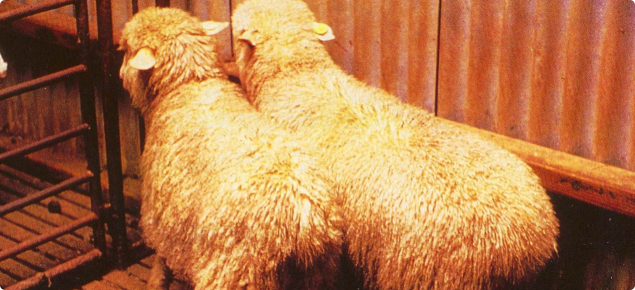Signs of cobalt deficiency:
Sheep are more susceptible to cobalt deficiency than cattle. It is seen more often in weaners and young animals due to their increased energy demand for growth.
In cattle and sheep, cobalt deficiency causes the following signs:
- reduced appetite and ill-thrift
- anaemia
- scaly ears.
In sheep:
- weepy eyes with damp matted wool below the eyes
- in some cases, wool break
- affected ewes may have small lambs.
In cattle:
- rough, pale coat and reduced milk production
- scours in calves
- a 'depraved appetite' ('pica'). Affected animals may eat bark, leaves or dirt.
Plant and climate factors affecting cobalt availability
Soil type
Cobalt deficiency mainly occurs on deep sandy soil, although it can also occur on sandy soils with mottled yellow clay subsoils, loamy sands and gravelly sands. In Western Australia, the highly weathered and leached soils are low in cobalt. Poorly drained soils are higher in cobalt and waterlogging increases the availability of cobalt to the plant.
Pasture species
Grasses contain about half the cobalt found in clover or capeweed growing on the same soil. Cobalt deficiency usually occurs in animals grazing rapidly growing, grassy pastures containing less than about 30% clover or capeweed.
Winter rainfall
There is a close relationship between climate and the incidence of cobalt deficiency. While deficiency is generally only seen in areas with a greater than 500-millimetre annual rainfall, it is the winter rainfall in the current year that has the most influence.
Winter rainfall influences cobalt availability in two ways: it leaches the cobalt from the soil but it also influences the pasture growth rate in the spring flush. Cobalt is not an essential nutrient for plants, so high growth rates in spring dilute the amount of cobalt in the plant.
Animal factors influencing the requirement for cobalt
Age
Newborn animals have low reserves and a high requirement for cobalt. Colostrum provides vitamin B12 but milk has low levels. Where pastures are likely to be low in cobalt, young animals should be treated at 6-8 weeks of age with injectable vitamin B12. Weaner sheep are also more prone to cobalt deficiency than adult animals.
Species
Sheep and goats appear to be more susceptible to cobalt deficiency than cattle. There is a higher incidence of signs of the disease in these species.
Worm burdens
Barber’s pole worm and scour worms cause loss of protein from the gut and a reduction in feed intake. Young animals with heavy worm burdens will be more susceptible to cobalt deficiency. Avoid weaning young animals onto pastures that are likely to have a high worm burden.
Testing for cobalt deficiency
The occurrence of cobalt deficiency is highly variable year-on-year, but ill-thrift, weepy eyes and anaemia in sheep in moderate to high rainfall areas after a wet winter and soft spring are highly suggestive of cobalt deficiency.
The following tests for cobalt deficiency are available:
- blood tests
- post-mortem assay
- pasture tests
- response test using injectable vitamin B12.
Blood tests can measure the level of a specific enzyme in the blood (methylmalonic acid or MMA), which increases when vitamin B12 is low.
At post-mortem, an assay for the level of vitamin B12 in the liver can be carried out.
Pasture tests do not routinely include a check for cobalt as it is not an essential nutrient for plants, but it can be done on request. Levels less than 0.04 parts per million (ppm) indicate the potential for deficiency (0.04–0.10ppm is considered marginal).
When cobalt deficiency is suspected, a response test can be done using injectable vitamin B12. Inject some of the group and compare their liveweight gains over the next few weeks with untreated animals.
Soil tests are unreliable.
Preventing cobalt deficiency
- Vitamin B12 injections provide the quickest response to treatment. A single injection of vitamin B12 will prevent the development of deficiency for 6–8 weeks. This is the best method for use for lambs at marking and calves pre-weaning. It can also be used for animals to be sold in the next two months (prime lamb, beef weaners).
- Intraruminal cobalt pellets, given using a ‘bulleting gun’, are better for long-term prevention of deficiency. In sheep, pelleting is best done when lambs are weaned. Pellets are not suitable for lambs less than eight weeks old. One pellet is effective for 1–3 years.
- Cobalt licks are available but the intake is highly variable.
- Cobalt sulphate drenches are available and cobalt is often included in multi-mineral drenches. The protective effect of cobalt given in this form only lasts about two weeks so the drench must be given frequently.
- Cobalt can be added to a fertiliser blend, but this is an expensive option and the cobalt given in marginal areas may be wasted in drier years.
- Pasture sprays with cobalt sulphate are also available. It is not necessary to treat the whole property. Grazing stock can be rotated through sprayed paddocks, or strips of spray can be applied in each grazing paddock during winter (July).
If you see unusual disease signs in your stock, call your private veterinarian, a veterinary officer at the Department of Primary Industries and Regional Development (DPIRD), or the Emergency Animal Disease hotline on 1800 675 888.
To find your local DPIRD Field Veterinary Officer, go to the DPIRD page Livestock biosecurity program contacts and click on 'Field Veterinary Officers'


